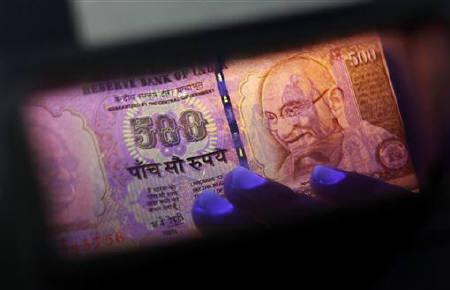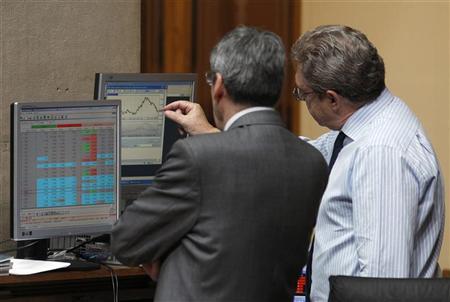Photographs: Courtesy, Business Standard Abhineet Kumar in Mumbai
Citigroup Global Markets veteran Rajiv Nayar is cautiously optimistic as he sees bouts of risk-on and risk-off sentiments affecting capital raising by Indian companies.
In his first free-wheeling interview after taking charge as the head of Capital Markets Origination in India, he talks about triggers for equity markets revival and the trend of investors shifting towards debt capital.
...
Much of the bad news is probably behind us: Citigroup India
Photographs: Yannis Behrakis/Reuters
From investors' point of view, how do you differentiate between the current slowdown and that in 2008?
The 2008 crisis for India was for a fairly brief period. Policy makers worldwide acted swiftly through a series of monetary and fiscal stimulus which benefited markets, including India.
If you look at QE1 (the first round of quantitative easing by the US government), it had a positive impact on the Indian markets, which recovered very swiftly. In addition, domestic policy measures, including increased levels of bank lending, stabilised consumption and investment levels. Hence, the capital markets in India recovered quickly from the events of 2008.
What we are seeing now is a more sustained slowing, not only in India but elsewhere in the world. We are seeing a slowing in growth and even recession in certain Euro zone countries. What we are witnessing in India is similar to what we are seeing in other parts of the world, as the benefits of additional stimulus measures wears off slowly. Of course, there are India-specific issues as well which have impacted our markets.
...
Much of the bad news is probably behind us: Citigroup India
Photographs: Rupak de Chowdhuri/Reuters
There is now talk of QE3. How do you look at that?
If there is a further round of monetary stimulus in the US and elsewhere, it will certainly help underpin asset prices and possibly result in a period of risk-on which will benefit markets, including India.
What are the silver linings you see amidst the current economic slow down?
There are many. One is that Indian markets have been among the best performers globally, year to date, and continue to attract strong FII flows. The rupee depreciated last year and the current account deficit should be lower this year. Commodity prices are easing and gold imports are slowing.
Interest rates are unlikely to go up further and the talk now varies around the degree and pace at which rates will ease. All these are positives for corporate India, as well as for the markets. Based on expectations of some positive policy announcements from the government, I believe we might have more bad news behind us than ahead of us.
...
Much of the bad news is probably behind us: Citigroup India
Photographs: Nicky Loh/Reuters
Debt levels of some companies in India are alarmingly high. Do you see that leading to a trend of equity issuances in order to de-leverage?
There are two different issues here. There are certain sectors where we see high leverage, such as power and infrastructure. This is because the delays in project implementation and higher input costs have resulted in lower earnings and higher leverage. I believe a much larger part of corporate India is not over-leveraged.
When you talk about highly leveraged companies accessing the equity markets, while theoretically logical, what really happens is when you are highly leveraged, then it would tend to affect your valuations.
...
Much of the bad news is probably behind us: Citigroup India
Photographs: Reuters
Consequently, valuations decline or are suppressed. For promoter-owned companies, issuing equity results in a higher than desired level of dilution. So, we are not necessarily going to see issuance from companies of the sectors that are highly leveraged.
In 2012, we have had a sustained period of risk-on and risk-off sentiments. Equity issuances during this period have been muted.
Year to date, we have seen $7.5 billion of fund raising, almost entirely from secondary activities such as block trades and OFS, with negligible primary issuances. Even this level is significantly lower than last year and the peak of $30 bn in 2010.
...
Much of the bad news is probably behind us: Citigroup India
Photographs: Brendan McDermid/Reuters
So, is selling non-core assets the only viable option before them?
Those who can do so will be looking at monetising non-core assets.
With the Sebi guideline for maintaining 25 per cent free float by listed companies coming closer, do you see that as a possible trigger that can revive equity markets?
If priced attractively by good companies, it could revive sentiments.
...
Much of the bad news is probably behind us: Citigroup India
Photographs: Tony Gentile/Reuters
What other possible triggers could revive the equity markets?
We have seen bouts of risk-on and risk-off sentiment in the markets. Markets look for some degree of stability and certainty. In terms of FII (foreign institutional investor) flows, the Indian market has done reasonably well and these are up 10-15 per cent year to date, with about $11 bn of inflow so far.
Valuations, obviously, have come off from the past levels. Further QE measures, some positive policy developments and divestments of quality public sector companies at attractive levels also have the potential to revive markets.
...
Much of the bad news is probably behind us: Citigroup India
Photographs: Shannon Stapleton/Reuters
What about the primary markets? Do we expect the IPO market to revive soon?
The markets are in a 17,000-18,000 range (Sensex). Citi has a 18,400 (Sensex) target for the year-end. The markets have performed reasonably well this year. We have had bouts of risk-on and risk-off, which makes it difficult for companies to tap the markets.
You typically need four to six months of stability and certainty to plan and execute in the primary markets. There is always a market for good companies. We managed the IPO for MCX earlier this year, which was overwhelmingly subscribed.
...
Much of the bad news is probably behind us: Citigroup India
Photographs: Babu/Reuters
Talking about debt markets, we have recently seen a spurt in dollar-denominated bond issuance by Indian banks. What makes it so attractive?
This is a much wider trend taking place in global capital markets. We are seeing a very significant shift at the investor level over the past few years, whether it is retail or institutional, towards fixed income markets and to some extent away from equity markets.
This is driving down yields and making funding from debt capital markets very attractive for issuers. Year to date issuances in global debt markets are at an all-time high. Asian issuances have exceeded $80 bn this year, in comparison to $65 bn for all of last year.
Indian issuances are about $5 bn, of which issuance by banks is around $3.5 bn. Indian issuers are now seeing the opportunity in terms of low treasuries that are at 30-year historical lows and tight credit spreads to raise long-term fixed rate financing from these markets.
...
Much of the bad news is probably behind us: Citigroup India
Photographs: Max Rossi/Reuters
So, there is a lot that India can still achieve in terms of growth for bond markets. What is holding it back and what can be done?
Historically, across Asia, including India, loan and bank markets have been larger relative to the bond markets. In the last five years, however, we have seen a very significant shift from loans to bond markets. These trends will continue globally and increasingly in India as well.
...
Much of the bad news is probably behind us: Citigroup India
Photographs: Brendan McDermid/Reuters
Indian companies have not been frequent issuers in the international bond markets because capital from international loan markets is available at very attractive levels. This is changing as global banks continue to re-size their balance sheets, driven by their own challenges and by upcoming regulatory changes.
Bond markets will continue to grow and Indian issuers are expected to increase their presence and participation in these. However, certain policy changes, such as lowering of withholding taxes, will obviously facilitate the growth process.
...
Much of the bad news is probably behind us: Citigroup India
Photographs: Reuters
Do you also see an upcoming trend for foreign bonds in other currency denominations?
There are various discussions around the Singapore dollar and the renminbi, which offer a good alternative to issuers to diversify their investor base and raise funding in shorter tenors.
However, the US dollar bond market is the world's largest pool of capital and is expected to remain so in the foreseeable future. So, the dollar will remain the predominant currency of issuance, although there may from time to time be opportunistic issuances in non-US dollar currencies.
...
Much of the bad news is probably behind us: Citigroup India
Photographs: Andrea Comas/Reuters
Where do you see the domestic bond markets heading to?
The transition we have seen in global capital markets from loans to bonds is something that will over time also occur in India. The Indian bond market has grown impressively in recent years.
It has almost doubled in five years. It is quite possible that the pace of change could accelerate in the next five years.















article